Potrebujeme váš súhlas na využitie jednotlivých dát, aby sa vám okrem iného mohli ukazovať informácie týkajúce sa vašich záujmov. Súhlas udelíte kliknutím na tlačidlo „OK“.
ASTM E262-13
Standard Test Method for Determining Thermal Neutron Reaction Rates and Thermal Neutron Fluence Rates by Radioactivation Techniques
Automaticky preložený názov:
Štandardná skúšobná metóda pre stanovenie tepelných neutrónov reakčnej rýchlosti a tepelných neutrónov Fluence Ceny by Radioactivation techniky
NORMA vydaná dňa 1.1.2013
Informácie o norme:
Označenie normy: ASTM E262-13
Poznámka: NEPLATNÁ
Dátum vydania normy: 1.1.2013
Kód tovaru: NS-45747
Počet strán: 11
Približná hmotnosť: 33 g (0.07 libier)
Krajina: Americká technická norma
Kategória: Technické normy ASTM
Kategórie - podobné normy:
Anotácia textu normy ASTM E262-13 :
Keywords:
ICS Number Code 17.240 (Radiation measurements), 27.120.30 (Fissile materials and nuclear fuel technology)
Doplňujúce informácie
| Significance and Use | ||
|
4.1 This test method can be extended to use any material that has the necessary nuclear and activation properties that suit the experimenter's particular situation. No attempt has been made to fully describe the myriad problems of counting techniques, neutron-fluence depression, and thick-foil self-shielding. It is assumed that the experimenter will refer to existing literature on these subjects. This test method does offer a referee technique (the standard gold foil irradiation at National Institute of Standards and Technology (NIST)) to aid the experimenter when he is in doubt of his ability to perform the radiometric technique with sufficient accuracy. 4.2 The standard comparison technique uses a set of foils that are as nearly identical as possible in shape and mass. The foils are fabricated from any material that activates by an ( n, γ) reaction, preferably having a cross section approximately inversely proportional to neutron speed in the thermal energy range. Some of the foils are irradiated in a known neutron field (at NIST) or other standards laboratory). The foils are counted in a fixed geometry on a stable radiation-detecting instrument. The neutron induced reaction rate of the foils is computed from the counting data, and the ratio of the known neutron fluence rate to the computed reaction rate is determined. For any given foil, neutron energy spectrum, and counting set-up, this ratio is a constant. Other foils from the identical set can now be exposed to an unknown neutron field. The magnitude of the fluence rate in the unknown field can be obtained by comparing the reaction rates as determined from the counting data from the unknown and reference field, with proper corrections to account for spectral differences between the two fields (see Section 4.3 This test method follows the Stoughton and Halperin convention for reporting thermal neutron fluence. Other conventions are the Wescott convention (followed in Test Method E481) and the Hogdahl convention. Practice E261 explains the three conventions and gives conversion formulae relating values determined by the different conventions. Reference 1.1 The purpose of this test method is to define a general procedure for determining an unknown thermal-neutron fluence rate by neutron activation techniques. It is not practicable to describe completely a technique applicable to the large number of experimental situations that require the measurement of a thermal-neutron fluence rate. Therefore, this method is presented so that the user may adapt to his particular situation the fundamental procedures of the following techniques. 1.1.1 Radiometric counting technique using pure cobalt, pure gold, pure indium, cobalt-aluminum, alloy, gold-aluminum alloy, or indium-aluminum alloy. 1.1.2 Standard comparison technique using pure gold, or gold-aluminum alloy, and 1.1.3 Secondary standard comparison techniques using pure indium, indium-aluminum alloy, pure dysprosium, or dysprosium-aluminum alloy. 1.2 The techniques presented are limited to measurements at room temperatures. However, special problems when making thermal-neutron fluence rate measurements in high-temperature environments are discussed in 9.2. For those circumstances where the use of cadmium as a thermal shield is undesirable because of potential spectrum perturbations or of temperatures above the melting point of cadmium, the method described in Test Method E481 can be used in some cases. Alternatively, gadolinium filters may be used instead of cadmium. For high temperature applications in which aluminum alloys are unsuitable, other alloys such as cobalt-nickel or cobalt-vanadium have been used. 1.3 This test method may be used to determine the equivalent 2200 m/s fluence rate. The accurate determination of the actual thermal neutron fluence rate requires knowledge of the neutron temperature, and determination of the neutron temperature is not within the scope of the standard. 1.4 The techniques presented are suitable only for neutron fields having a significant thermal neutron component, in which moderating materials are present, and for which the average scattering cross section is large compared to the average absorption cross section in the thermal neutron energy range. 1.5 Table 1 indicates the useful neutron-fluence ranges for each detector material. Foil Material |
Form |
≈ Useful Range (neutrons/cm 2) |
|
Indium |
pure or alloyed with aluminum |
103 to 1012 |
|
Gold |
pure or alloyed with aluminum |
107 to 1014 |
|
Dysprosium |
pure or alloyed with aluminum |
103 to 1010 |
|
Cobalt |
pure or alloyed with aluminum |
1014 to 1020 |
1.6 This standard does not purport to address all of the safety concerns, if any, associated with its use. It is the responsibility of the user of this standard to establish appropriate safety and health practices and determine the applicability of regulatory limitations prior to use.
|
Standard Practice for Measuring Neutron Fluence Rates by Radioactivation of Cobalt and Silver |
|
|
Standard Guide for Detector Calibration and Analysis of Radionuclides in Radiation Metrology for Reactor Dosimetry |
|
|
Standard Practice for Determining Neutron Fluence, Fluence Rate, and Spectra by Radioactivation Techniques |
|
|
Standard Practice for Use of the Terms Precision and Bias in ASTM Test Methods |
|
|
Standard Terminology Relating to Radiation Measurements and Dosimetry |


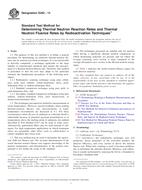
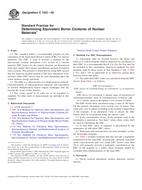 ASTM C1233-09
ASTM C1233-09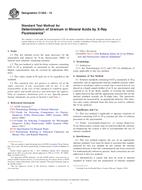 ASTM C1254-13
ASTM C1254-13 ASTM C1255-11
ASTM C1255-11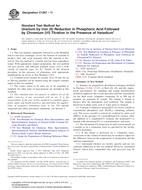 ASTM C1267-11
ASTM C1267-11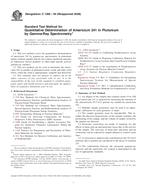 ASTM C1268-94(2008)..
ASTM C1268-94(2008)..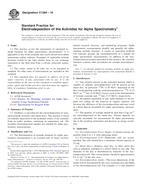 ASTM C1284-10
ASTM C1284-10
 Cookies
Cookies
